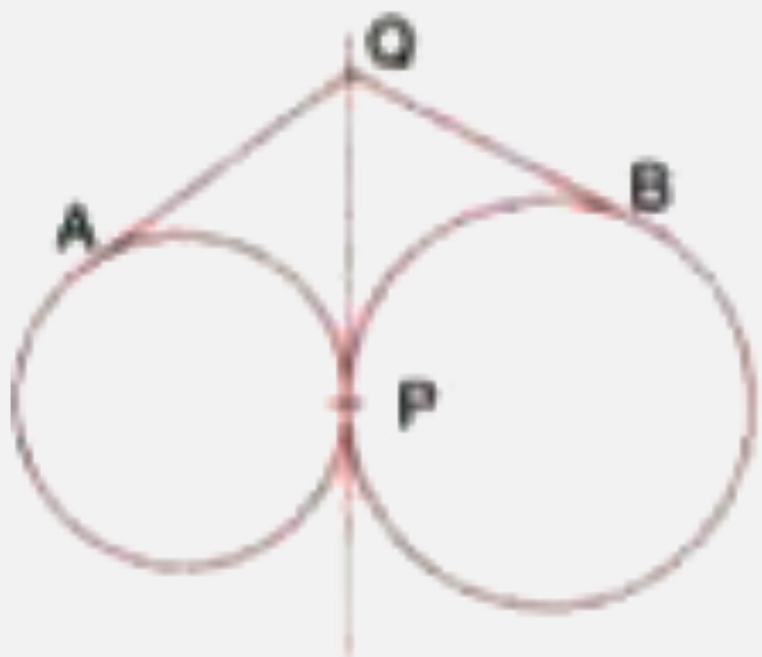Three circles whose radii are a,b and c and c touch one other externally and the tangents at their points of contact meet in a point. Prove that the distance of this point from either of their points of contact is (abca+b+c)12.
To prove that the distance from the point where the tangents at the points of contact of three externally touching circles meet to either of their points of contact is given by the formula √abca+b+c, we can follow these steps:
1. Draw the Diagram:
- Let the three circles have centers A, B, and C with radii a, b, and c respectively.
- The circles touch each other externally at points D, E, and F.
2. Identify the Tangents:
- Let the tangents from point I (the point where the tangents at the points of contact meet) to the points of contact D, E, and F be ID, IE, and IF respectively.
3. Use the Tangent Properties:
- By the property of tangents from a point to a circle, we have:
ID=IE=IF=r
- Here, r is the length of the tangent from point I to the points of contact.
4. Construct the Triangle:
- The points A, B, and C form a triangle with sides b+c, c+a, and a+b.
5. Calculate the Semi-Perimeter:
- The semi-perimeter s of triangle ABC is given by:
s=(b+c)+(c+a)+(a+b)2=a+b+c
6. Area of Triangle:
- The area Δ of triangle ABC can be calculated using Heron's formula:
Δ=√s(s−(b+c))(s−(c+a))(s−(a+b))
- Substituting s:
Δ=√(a+b+c)(a)(b)(c)
7. Radius of the Incircle:
- The radius r of the incircle of triangle ABC can be expressed as:
r=Δs
- Substituting the values of Δ and s:
r=√(a+b+c)(a)(b)(c)a+b+c
- Simplifying this gives:
r=√abca+b+c
8. Conclusion:
- Thus, the required distance from the point I to any of the points of contact D, E, or F is:
√abca+b+c
- This completes the proof.
- Let the three circles have centers A, B, and C with radii a, b, and c respectively.
- The circles touch each other externally at points D, E, and F.
- Let the tangents from point I (the point where the tangents at the points of contact meet) to the points of contact D, E, and F be ID, IE, and IF respectively.
- By the property of tangents from a point to a circle, we have:
ID=IE=IF=r
- Here, r is the length of the tangent from point I to the points of contact.
- The points A, B, and C form a triangle with sides b+c, c+a, and a+b.
- The semi-perimeter s of triangle ABC is given by:
s=(b+c)+(c+a)+(a+b)2=a+b+c
- The area Δ of triangle ABC can be calculated using Heron's formula:
Δ=√s(s−(b+c))(s−(c+a))(s−(a+b))
- Substituting s:
Δ=√(a+b+c)(a)(b)(c)
- The radius r of the incircle of triangle ABC can be expressed as:
r=Δs
- Substituting the values of Δ and s:
r=√(a+b+c)(a)(b)(c)a+b+c
- Simplifying this gives:
r=√abca+b+c
- Thus, the required distance from the point I to any of the points of contact D, E, or F is:
√abca+b+c
- This completes the proof.
Similar Questions
Three circles touch each other externally. The tangents at their point of contact meet at a point whose distance from a point of contact is 4. Then, the ratio of their product of radii to the sum of the radii is
View SolutionThree circles touch each other externally. The tangents at their point of contact meet at a point whose distance from a point of contact is 4. Then, the ratio of their product of radii to the sum of the radii is
View SolutionThree circles with radius r1,r2,r3 touch one another externally. The tangents at their point of contact meet at a point whose distance from a point of contact is 2. The value of (r1r2r3r1+r2+r3) is equal to
View Solution3 circles of radii a,b,c(a<b<c) touch each other externally and have x-axis as a common tangent then
View SolutionCircles with radii 3, 4 and 5 touch each other externally. If P is the point of intersection of tangents to these circles at their points of contact, then if the distance of P from the points of contact is λ then λ2 is _____
View SolutionCircles of radii 3,4,5 touch each other externally . Let P be the point of intersection of tangents of these circles at their points of contact .Show that the distance of P from a point of contact is √5.
View SolutionTwo circles touch each other externally at point P. Q is a point on the common tangent through P. Prove that the tangents QA and QB are equal.

View SolutionProve that the tangent at any point of circle is perpendicular to the radius through the point of contact.
View SolutionProve that the tangent at any point of circle is perpendicular to the radius through the point of contact.
View SolutionIf a circle, whose centre is (-1,1) touches the straight line x+2y = 12, then the co-ordinates of the point of contact are
View Solution
